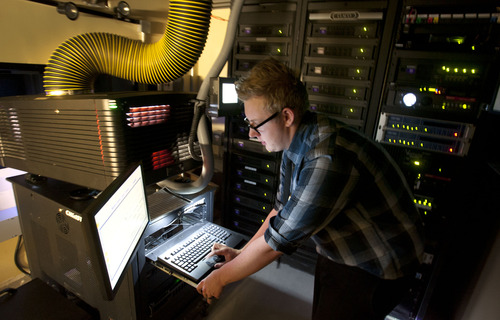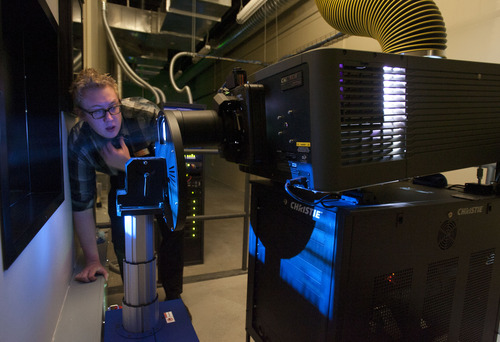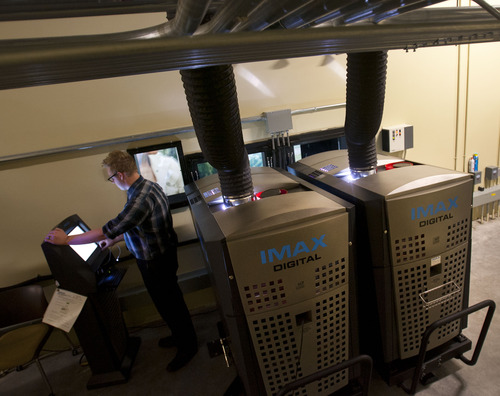This is an archived article that was published on sltrib.com in 2012, and information in the article may be outdated. It is provided only for personal research purposes and may not be reprinted.
Director Peter Jackson wants to make sure fans of "The Hobbit" will see every green wood splinter, leafy fern and earthy morsel from "second breakfast."
For Friday's upcoming 3D release of Jackson's much-anticipated adaptation of J.R.R. Tolkien's famous novel, the director is employing a new and controversial filmmaking technique that could be a glimpse into the future of movie exhibition technology.
It is the first movie to be projected at 48 frames per second, twice the speed of the normal 24 frames, which is supposed to add increased clarity and detail to the picture.
"It's high-definition 3D," said Adam Tillman, director of digital cinema for Megaplex Theatres, the chain owned by the Larry Miller Group. "With 24 frames per second, when you get a lot of movement, it would almost hurt my eyes because it wasn't quite clear enough. But with 48 frames per second, it seems a lot more clear."
A vast majority of movie screens will show the movie in standard 24 frames per second. But four Megaplex screens in theaters from Centerville to South Jordan will show "The Hobbit" in 48 frames, and the IMAX screen at its Jordan Commons complex in Sandy will be one of only nine in the country showing it in the new high-speed process.
The film also is playing in that format on two screens each at the Cinemark at Jordan Landing in West Jordan and at the Cinemark in Draper. Only about 450 of 4,500 U.S. movie screens will show "The Hobbit" in this faster projection technology.
The high-speed process is the latest technology that theater owners are turning to help beef up audience numbers.
"Theater owners want the movie theater to be the best and most desirable presentation for a movie," said Patrick Corcoran, director of media and research for the industry group National Association of Theater Owners. "Whether that involves digital sound or digital projection or stadium seating or 48 frames per second, there is a lot of new technology. We want to be on the cutting edge."
Projecting movies above the nearly century-old standard of 24 frames per second is not altogether new. In the late 1970s and early 1980s, movie special effects wizard Douglas Trumball ("2001: A Space Odyssey," "Close Encounters of the Third Kind") invented a process called Showscan designed to display film at 60 frames per second. Trumball reasoned that human eyesight sees 60 images per second, so when a movie is projected at 24 frames per second our brains must fill in the missing images. By projecting the full number of images to our eyes the theory went, the film would look more realistic, as though you were looking through a window.
But Trumball's Showscan was used only for motion rides at amusement parks, and his process was never widely adopted in regular movie theaters. With the advent of digital filmmaking and projection, which doesn't produce unsteady flicker the way celluloid did, Jackson and fellow filmmaker James Cameron ("Avatar," "Titanic") started touting the 48-frames-per-second technology. Cameron says he expects to employ the technique for his "Avatar" sequels.
Movie theaters that already have digital projectors don't have to invest much to convert to the new process. Depending on the model, going to the 48-frame-per-second technology can require just a software and firmware upgrade or the installation of a small box to the projector that would cost about $10,000, Tillman said.
The new projection process is not without argument, however. Critics who saw early screenings of "The Hobbit" last week said the hyper-realistic look highlighted the flaws in sets and special effects. Others said it appeared more like videotape instead of film, and they compared the movie's look to that of a TV soap opera.
"The intense clarity made it look as if actors with wet hair were moving between carefully placed artificial rain-makers instead of suffering through an actual downpour," wrote Associated Press reporter Ryan Nakashima. "So-so acting was more noticeable, and swords that were swung too easily looked like props. Flickering flames and other quickly moving objects sometimes appeared to race along in fast forward, even though that wasn't the intent."
Others at a preview tweeted that the process made them feel queasy, as if they suffered motion sickness. Megaplex's Tillman said he was cautiously optimistic about the process and doubted it would make most audience members sick.
"The problem is we just don't know, and that is due to the fact that everyone is different," he said. "They will have their own opinions and different sensitivities. It will have to be one of those things we watch."
One of the groups that also will be watching closely is Hollywood studios. Tillman said "Hobbit" distributor Warner Bros. is nervously awaiting the reaction to the high-speed process in hopes it can attract bigger audiences. Plus, the next two "Hobbit" films (the book is being adapted as a trilogy of films) are expected to be presented with the same process.
"As soon as 'The Hobbit' is released, that will either make or break the technology," Tillman said. "That's why Warner is so nervous about it."
So far, Hollywood is on track to have a record-breaking box-office year, with as much as $11 billion in revenue, thanks to blockbuster films such as "The Avengers" and the new "Twilight" sequel," said Corcoran of the theater owners group. But the popularity of 3D movies — which came on the scene several years ago in response to the rise of home-movie watching — has been waning.
When "Avatar" was released in 2009, 89 percent of its box office came from 3D shows. This year's 3D showings of "Brave," Pixar's latest release, generated only 32 percent of its total box office, according to The Hollywood Reporter, an all-time low. Corcoran insists that movies shown in 3D still generate 40 percent to 60 percent of a film's total revenue.
Tillman hopes the added benefit of 48 frames per second, which is being used only in conjunction with 3D screenings, will help turn that around.
"The studios are trying to revive 3D," he said. "This could actually help pick that back up. We'll have to see how it goes."
Google+: +Vincent Horiuchi —
New at movie theaters
Displaying "The Hobbit" at 48 frames per second and in 3D are not the only technologies employed for the movie. Others are:
Dolby Atmos • A new sound system for movie theaters that employs 56 speakers with 53 different sound channels, much more than a standard movie theater. The speakers are not only on the walls but in the ceiling, resulting in sound effects that envelop the viewer. Only one auditorium in Utah — at the Megaplex Theatre in the Valley Fair Mall — uses the system.
D-Box • An immersive type of theater seat with force feedback similar to the "Sensurround" gimmick of the 1970s. But this system, available at select Megaplex Theatres, is much more sophisticated and can not only rumble but also sway, dip and jolt the viewer's in synchronization with the movie's action.







